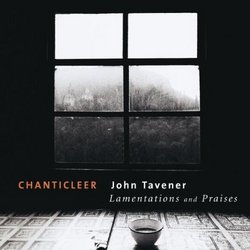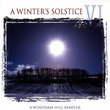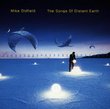| All Artists: Chanticleer, Tavener Title: Tavener: Lamentations & Praises Members Wishing: 0 Total Copies: 1 Label: Teldec Release Date: 1/29/2002 Genre: Classical Style: Opera & Classical Vocal Number of Discs: 1 SwapaCD Credits: 1 UPC: 809274134226 |
Search - Chanticleer, Tavener :: Tavener: Lamentations & Praises
 | Chanticleer, Tavener Tavener: Lamentations & Praises Genre: Classical
The composer calls this work "a liturgical drama," but there is nothing dramatic about it; it is more aptly described by the title of its three main sections, "Stasis." Set to texts from the Greek and Russian Orthodox East... more » ![header=[] body=[This CD is available to be requested as disc only.]](/images/attributes/disc.png?v=15401716) ![header=[] body=[This CD is available to be requested with the disc and back insert.]](/images/attributes/disc_back.png?v=15401716) ![header=[] body=[This CD is available to be requested with the disc and front insert.]](/images/attributes/disc_front.png?v=15401716) ![header=[] body=[This CD is available to be requested with the disc, front and back inserts.]](/images/attributes/disc_front_back.png?v=15401716) |
Larger Image |
CD DetailsSynopsis
Amazon.com The composer calls this work "a liturgical drama," but there is nothing dramatic about it; it is more aptly described by the title of its three main sections, "Stasis." Set to texts from the Greek and Russian Orthodox Easter service sung in English interspersed with ancient Greek words, it is scored for male voices and an odd combination of strings, winds, and extra-large percussion instruments including a Byzantine monastery bell, a Tibetan temple bowl, a tam-tam, and a simantron (a wooden board struck with a hammer). The music, in Tavener's characteristic medieval, monastic, Byzantine style, is devout, contemplative, very slow, with endlessly sustained notes and chords, and based on structurally determined repetition. Anchored by bass or descant drones, the chorus moves in parallel chordal progressions, alternating with ornate, melismatic solos, and punctuated by regularly repeated crashes from the bell and bowl. Variety is created through changes of key, vocal and instrumental texture, and motivic material. Several sections culminate in climactic buildups of volume and intensity. Some of the music is very beautiful, but its repetitiousness and basically unchanging character make a sense of monotony unavoidable. Perhaps only listeners who share Tavener's own deep spirituality can fully enter into his musical world. The performance by Chanticleer is wonderful. The voices float with a transparent, pure, otherworldly sound--it seems unbelievable that the altos and sopranos, who go up to high F's and G's, are really male singers--and the instruments match them perfectly in tone and style. --Edith Eisler Similarly Requested CDs
|
CD ReviewsTavener and Chanticleer: a heavenly combination... Eric McCalla | Denver, COLORADO | 02/14/2002 (5 out of 5 stars) "John Tavener's Lamentations and Praises is almost indescribably perfect in its premiere recording by Chanticleer. As Chanticleer was the co-commissioner of this work, they have a great understanding of the music and the words. Their voices are grouped SATB (soprano, alto, tenor and bass/baritone, as is common in many liturgical choral pieces. The soprano voices of Matthew Alber, Christopher Fritzsche, and Ian Howell are simply amazing in their range and clarity. Not to take away from the other soloists in the lower ranges, but to hear male voices singing at such high octaves is nothing short of wondrous!If you are new to Tavener, Lamentation and Praises is an excellent introduction to the "modern" period of his compositions that really started with Eternity's Sunrise, composed and performed in collaboration with the Academy of Ancient Music. Tavener has been composing from a very young age, and recording since the mid to late 1960s, when Tavener recorded The Whale on the Beatle's Apple label. It was an unqualified and riotous success. Tavener then and since has made frequent use of tape playback, unusual voicing combinations, Eastern and Byzantine vocal modalities, as well as a mix of contemporary and classical compositional forms to write simple and complex works for voice, chamber ensembles, and solo strings (most popularly his solo cello concerto, The Protecting Veil, is literally his most successful piece and has been recorded several times over by many cellists and orchestras.)If you are familiar with Tavener's music of the past 15 years or so, then you will hear references in Lamentations and Praises to earlier works. For him a composition might undergo years of re-working, or he might borrow a motif or sound mode and bring it to a newer piece. For example, the melismatic vocal style heard here is found in his superbly dramatic sacred "cantata", We Shall See Him As He Is, recorded in a live performance at London's Proms circa 1989. That work is also divided into sections he called Ikons, each one a depiction of a significant event in the life of Christ. The melisma is also heard strongly in his dirge, Eis Thanaton, and in the stunning Innocence, recorded in collaboration with Martin Neary, Director of Music at Westminster Abbey. He also used tape playback on Tears of the Angels, as well as Eis Thanaton, among several others. The use of Asian/Eastern modes is also heard on last year's Total Eclipse, which also made us of melisma and Byzantine vocal modalities.Tavener's use of the Ison or drone sound is found in many of his works as he uses it to represent the continuous or eternal/omnipresent existence of God. This is most evident in his work with the Tallis Scholars called Ikon of Light, where a continuous vocal line through the ENTIRE piece is used to represent God, who manifests his presence through the physical medium of light. In Lamentations you hear the Ison at different volumes and in different sections, not continuously, so it's not always apparent. So many of these disparate elements are what make EXPERIENCING Tavener on disc so special, as you can return to those moments or Ikons that resonate most deeply within your psyche or your soul. For every person I truly believe Tavener's work speaks differently, but with great power to inspire all of us to greater and deeper contemplation.Much comment has been made of Teldec (Warner Music) and Chanticleer not providing more information in the CD's booklet. While the liner notes are scant, they do give you some useful insight into how Lamentations is structured. If you want an in-depth knowledge of Tavener's compositional process, I'd very highly recommend two books: The Music of Silence: A Composer's Testament and Visions of Paradise. The first book is a series of discussions between Tavener and a music writer, the interviews having been conducted over several months. Visions of Paradise is a biography and offers a thorough and interesting survey of both the work and life of the composer, which are really one and the same for Tavener. Lastly, I found the photos in the Lamentations booklet to be both appropriate and beautiful, enhancing the overall packaging.This CD is one of Tavener's greatest works!" Not for the easily depressed Mark DeSilets | San Jose, CA USA | 02/20/2002 (3 out of 5 stars) "A powerful piece of music, with the characteristically beautiful performance that Chanticleer is famous for. The subject is not a happy one, and the music conveys the sense of dread and anguish that was probably Tavener's intent. This music is emotionally evocative, but will surely darken and make more somber whatever mood you start listening with, so let the listener take heed! I appreciate the brilliance of the performance, but I can't really say I *like* the music. Recorded in techologically pristine fashion, as we have come to expect from Chanticleer." No documentation? No surprise! Saw the first performance at Stanfo | Sunnyvale, CA USA | 01/29/2003 (5 out of 5 stars) "Just to respond to the comments about the lack of liner notes: When this work was recorded, the music was still wet on the page. Indeed, Tavener had approved several changes very late in the game, as you might expect. When you do a world-premiere recording of a brand new piece, you can't exactly round up the nearest musicologist and ask for a detailed essay about the music (as you might for, say, Josquin)!Anyway, I found the piece quite moving, and the performance here is flawless."
|

 Track Listings (19) - Disc #1
Track Listings (19) - Disc #1








